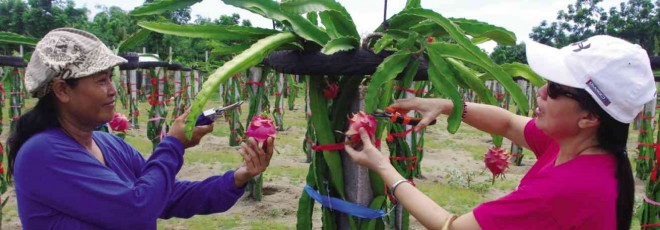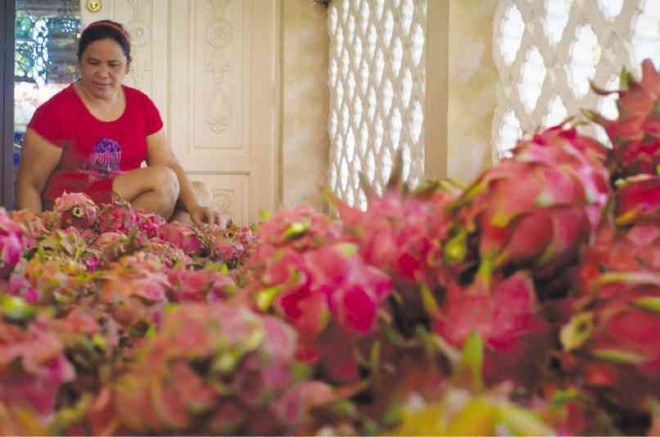Dragon fruit picking a craze among tourists

AGNES Asuncion (left), farm manager of the Nagbacalan Dragon Fruit Farm in Paoay town in Ilocos Norte province, assists a tourist in picking dragon fruits. LEILANIE ADRIANO
Ever wonder how a simple Ilocano backyard planted with few cuttings of a fruiting cactus that blooms at night could lighten up roadsides and plantations in Ilocos Norte province’s public and private lots?
Plant lovers and fruit enthusiasts have been amazed to see how the popularity of Ilocos Norte’s odd-looking dragon fruit spread in the country and abroad, where the Philippines displays its high value fruits and exotic products to the world market.
The dragon fruit cultivation technology, featuring a zero-waste management system, has produced a variety of products derived from the fruit—from its dried flowers down to its roots.
Backed by technology developed by various government research institutions and agencies, including local governments, Ilocos Norte can now claim the title as the “organic dragon fruit capital of the Philippines.”
Pioneer
Article continues after this advertisementCredit goes to entrepreneur Edita Dacuycuy, 69, who pioneered the cultivation of dragon fruit in her backyard eight years ago and spread her passion to other farmers when she was invited by the United States government as panelist during the Asia-Pacific Economic Cooperation-Women and Economy Summit in San Francisco, California, in September 2011.
Article continues after this advertisementThe 13-hectare Refmad Farms, which Dacuycuy manages with her daughter, Mildred, in Barangay (village) Paayas in Burgos town, serves as a laboratory for farmers and investors who may want to produce dragon fruit all-year round.
The farm uses the extended daylight technology that prolongs the cactus plant’s exposure to artificial sunlight during its off-season from December to April.
Facing El Niño
Anticipating the impact of the El Niño phenomenon starting this October, the first dragon fruit plantation in Northern Luzon has established at least two units of wind pump (a type of windmill used in pumping water), with a capacity of 2,000 gallons, to sustain the growth of dragon fruit cactus plants even on summer months.
Refmad Farms is also taking a page from the success of Benguet province’s strawberry plantations by restaging in October a dragon fruit picking festival, which was first held in July last year.
During the festival, the farm will be open to tourists from 7:30 a.m. to 5 p.m. so they can experience picking fresh dragon fruits and buying these at the farm gate price of P100 to P150 a kilo.
Festival organizers say they hope dragon fruit picking will become a craze among tourists.
The farm will also offer free tasting of dragon fruit varieties like Thai white, Vietnam white, Moroccan, Red China and Ilocos Saniata, a local variety named by the association of dragon fruit growers in the province.
Fun and excitement
“Refmad Farms shares the fun and excitement of harvesting dragon fruit, which has now become a source of additional income to our local farmers, including our students, out of school youth, housewives and persons with disabilities who ventured into dragon fruit farming technology. Some of them are also helping at the farm,” says Dacuycuy, president of the National Council for Dragon Fruit Growers of the Philippines (NCDFGP).
She says dragon fruit growers of Ilocos Norte have met with growers in the country and Filipino-American immigrants, mostly based in Hawaii and mainland US, to urge them to invest in dragon fruit farming in the Philippines.
Dacuycuy says the NCDFGP has established ties with business groups from Germany, London, Singapore, Macau and Hong Kong.
With the high demand for this exotic fruit known for its therapeutic properties, idle public and private lands in Ilocos Norte, including village roadsides, backyards and school compounds, have been turned into pocket dragon fruit farms.
Vine of life
Ilocanos refer to the dragon fruit as the “vine of life” because of its health benefits and the additional income that it gives to local communities and schools.
Dragon fruit growers in Ilocos Norte have been cultivating about 300 ha and have started expanding to various parts of the country to reach a cultivation area of 1,000 ha. Local growers say they need at least 40 tons of dragon fruit to fill a container van.
While fresh dragon fruit sustains the industry, growers continue to develop other products that have found a steady market. Among these are ice cream, jam, wine, vinegar, tea, cookies, pastries and bars of soap.
